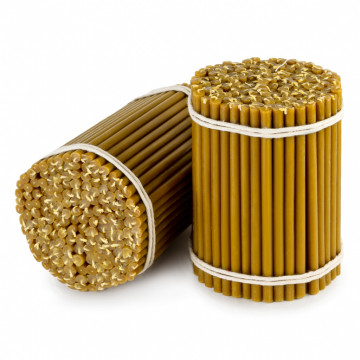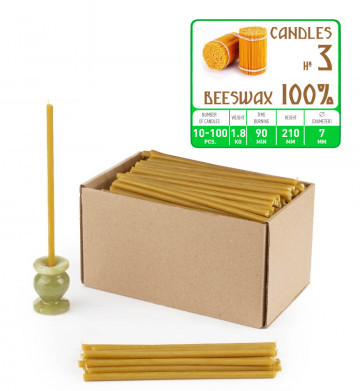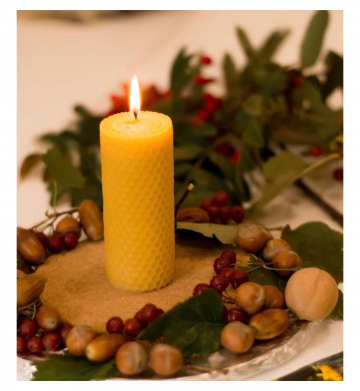
1. CANDLES EXISTED AS EARLY AS 500 BC.
They were made by the Romans from animal fat very early on to be used in honor of the birth of Artemis (the goddess) on the sixth day of each lunar month.
2. THERE IS A RIGHT WAY TO BURN A CANDLE!
You might think it’s simple—just light the candle... well... it’s a bit more complicated! Did you know that the first burn of a candle is the most important? When you light a candle for the first time, you should let it burn long enough!!!!!!! The entire top layer of wax must become liquid, and this takes several hours depending on the size of the candle. If you don’t do this, the candle will burn unevenly.
3. CANDLE WAX WAS CONSUMED DURING TIMES OF FAMINE.
In the old days, candle wax was mainly made from animal products such as beef tallow or beeswax. During famines, it was not uncommon for candles to be stolen to be eaten by the starving.
4. YOU SHOULD NOT BLOW OUT A CANDLE TO EXTINGUISH IT.
Blowing out a candle creates soot and smoke, which is not very pleasant. You also risk blowing hot liquid wax onto the surrounding area. TIP: The best (actually only!!) way to extinguish a candle is to use a candle snuffer, as it extinguishes the flame by depriving it of oxygen. When using a Frændi candle, you just need to put the lid on the container, easy!
5. CANDLE PRODUCTION IN THE EU IS GROWING.
Candle production in the EU in 2018 amounted to 1.638 billion euros. This is 11% more compared to 2013 (source: Eurostat).
6. FREEZING A CANDLE WILL NOT MAKE IT LAST LONGER.
Many people say that if you freeze a candle before lighting it, it will burn longer. Sorry... but this is fake news! Freezing a candle actually causes the wax to crack and damages the candle.
7. POLAND IS THE LARGEST CANDLE PRODUCER IN THE EUROPEAN UNION.
In 2018, Poland was the largest candle producer in the EU. It accounted for 619 million euros (38%) of all candles produced in the EU. Germany and Italy take the second and third places and account for 10% of the value of candle production in the EU in 2018 (source: Eurostat). Candles from non-EU countries mainly came from China, the USA, and Vietnam.
8. A CANDLE SHOULD NOT SMOKE WHEN BURNING.
There is no smoke without fire, of course... but if your candle smokes, the wick is too long! This is easily fixed: extinguish the flame, wait for the wick to cool, and trim it to a length of about 6 mm.
9. A CANDLE THAT HAS STARTED TO TUNNEL CAN BE SAVED.
When you manage to melt the wax only near the wick, a ring of hard wax remains on the outer edges, and this is not very pleasant. This is called tunneling. The only thing you need to do is cover the top of the candle with foil. Then cut a hole in the center where the wick is. This helps the hard outer wax soften and melt evenly. Burn the candle for several hours with the foil cover until the entire top layer is liquid.
10. SCENTED CANDLES HAVE A BIG IMPACT ON YOUR TASTE BUDS.
Our sense of taste greatly depends on our sense of smell. Therefore, be careful when using scented candles at the dining table. This is one of the reasons why we decided to create only unscented candles at Frændi.
11. CANDLES WERE MADE FROM WHOLE FISH.
It’s called the "candlefish" or Eulachon. This fish has such a high-fat content that it can be used as a candle.
12. THE FLAME OF A CANDLE DOES NOT ALWAYS STAND STRAIGHT.
Did you know that in microgravity conditions (for example, on a space station), some NASA scientists discovered that the flame has a spherical shape? This phenomenon is explained by the absence of gravity.
13. CANDLE MAKERS ARE CALLED CHANDLERS.
Cock-a-doodle-doo! It comes from the Old French word "chandelier." Before the advent of electricity, a "chandelier" was a ceiling fixture with multiple candles to light up rooms.
14. CANDLES WERE MADE FROM COWS, INSECTS, AND WHALES.
Not all candles are vegan and natural! In Europe, during the Middle Ages, tallow (a byproduct of beef fat) was popular for making candles. Candles were also made from wax obtained from insects and seeds. They were even made from spermaceti extracted from sperm whales and various plants. Nowadays, candles are mostly made from paraffin, beeswax, soy, and many types of wax.
15. PLACING CANDLES ON CAKES IS AN ANCIENT GREEK TRADITION.
True. The ancient Greeks offered a cake decorated with candles. It represented the glowing moon, in the temple of Artemis, the goddess of hunting and the moon. This became a birthday celebration tradition only since the 1700s, as each candle represented each passing year.






